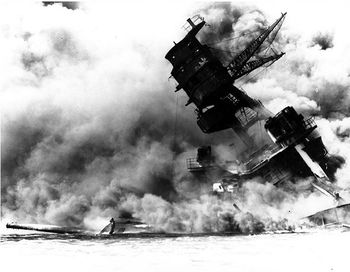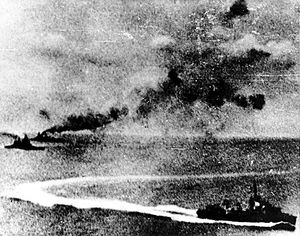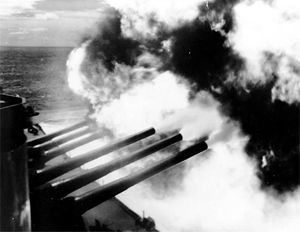Battleship
The 20th century battleship, although obsolete as a naval weapon, evolved from the ship of the line, as a naval vessel intended to engage the most powerful ships of an opposing navy. Their main armament were multiple heavy cannon in turrets [1], and they were heavily armored and designed to survive punishment from other battleships.
A general criterion, especially after the revolution of HMS Dreadnought (1905), is that the armor of a true battleship is sufficient to withstand a hit by its own most powerful gun, under certain constraints. Battlecruisers, while having battleship guns, did not meet this standard of protection; battlecruisers were intended to be fast enough to run from a battleship.
While there are references to "coastal battleships", it should be assumed that a true battleship is a seaworthy vessel that can be used for power projection.
Pre-dreadnoughts
Pre-dreadnoughts were steam-powered, usually coal-fueled, armored warships with a typical main battery of four heavy guns. They also had a secondary battery of large guns, plus a tertiary battery of medium guns for such purposes as defense against fast attack craft.
Some have suggested that USS Monitor might have been the prototype, but, while she had a single armored turret of heavy guns, she was so unseaworthy that she was limited to calm coastal waters, and, outside the specialized environment of the American Civil War, had no power projection capability. Still, the Battle of Hampton Roads (1862) arguably presaged later battleship duels.
Even though some were under construction when HMS Dreadnought (1905) was launched, they were immediately obsolete. A pre-dreadnought fighting a dreadnought could only engage with its heaviest guns, and the pre-dreadnoughts were also slow and unable to pursue weaker warships or commerce. They were scrapped, or assigned to missions such as coastal defense or shore bombardment.
Dreadnoughts
For a ship that only fought once, and that by ramming a German submarine, HMS Dreadnought (1905) made every other battleship in existence, or under construction, obsolete. Admiral Jacky Fisher can fairly consider himself her father, insisting on the characteristics: guns of a single large caliber, in turrets; and high speed. Her large-caliber guns made irrelevant the intermediate-caliber guns of other battleships, as they could not get close enough to use them.
"Big gun" usually meant 12"/300mm or larger. Pre-Dreadnought battleships might have secondary batteries of 9.2 or 8" guns, apparently intended to fight cruisers while fighting battleships.
The Diversion of the Battlecruiser
A less successful creation of Fisher, the idea of the battlecruiser was a vessel with battleship-caliber guns, very high speed, and reduced armor, so it could kill whatever it could catch and run away from whatever could kill it. Unfortunately, those large guns were seductive to battleship admirals, and, rather than using it as a cruiser killer and commerce raider, succumbed to the temptation of adding battlecruiser firepower to a battleship engagement.
As Admiral Sir David Beatty, commanding the battlecruisers at the Battle of Jutland observed as the second of his battlecruisers exploded and sank, "there seems to be something wrong with our bloody ships today." This should not have been a mystery: the "something" was inadequate armor for the role in which they were placed.
Especially after Jutland, battlecruisers were in search of a mission. Few were built. The German WWII battlecruisers DKM Scharnhorst and DKM Gneisenau had some success as commerce raiders, but Scharnhorst died in battle against a true battleship, HMS Duke of York. HMS Hood also sank in a surface gunfire action, in 1940, fighting the battleship Bismarck and the cruiser Prinz Eugen; the shell that caused Hood to explode, however, is believed to have come from Prinz Eugen.
Some ships, such as the USS Alaska and Guam, were "large cruisers", and even more in search of a mission; they were less heavily gunned than battlecruisers.
The "pocket battleship", such as DKM Graf Spee, was really a media term; she was lighter than a battlecruiser and, for a time, an effective commerce raider. She was mission-killed by two light cruisers and a heavy cruiser at the Battle of the River Plate.
Some battlecruisers, under construction at the time of the Washington Naval Treaty, would have had to be scrapped if continued, so were converted to aircraft carriers; this was the origin of the U.S. Lexington-class.
Early losses in WWII
One of the failures of U.S. preparation for the Battle of Pearl Harbor was an assumption that aircraft could not deliver torpedoes, the most powerful weapon against armored ships, in the shallow waters of the harbor. On the night of 11-12 November 1940, British carrier-based torpedo aircraft attacked the Italian fleet at the Battle of Taranto. Three battleships were hit and disabled, with two out of service until mid-1941 and the Conte di Cavour never repaired. In their planning, the Japanese were very aware of the capabilities demonstrated at Taranto.
At the Battle of Pearl Harbor, USS Arizona exploded and settled to the bottom, her superstructure partially above the shallow water; her wreck is now a memorial. The exceptional violence of the explosion has never been definitively explained. It was caused by one or more bombs from high-level bombers. "...since the bomb apparently did not pierce Arizona's armored deck, which protected her magazines. Many qualified authorities have blamed powder storage outside of the magazines as the cause, but this is conjectural and probably will always remain so. In any case, the battleship was utterly devastated from in front of her first turret back into her machinery spaces. Her sides were blown out and the turrets, conning tower, and much of the superstructure dropped several feet into her wrecked hull. This tipped her foremast forward, giving the wreck its distinctive appearance."[2]
USS Oklahoma later sank while being salvaged. All the other battleships at Pearl Harbor were damaged, but eventually returned to service: USS Nevada, USS California, USS Tennessee, USS Maryland' and USS West Virginia. All were to fight again, but not as the core of a surface force, except at the Battle of Surigao Strait — more of an execution than a battle. For the limited surface gunfire actions between battleships in the Pacific, only later classes were to see action.
Those ships were at anchor, and arguably less vulnerable than a maneuvering vessel at sea. Neverthless, three days later, the British battleship HMS Prince of Wales and battlecruiser HMS Repulse were sunk by Japanese aircraft.
Later classes
Interwar designs such as the U.S. South Dakota-class or German Bismarck-class had 15-16" main batteries, secondary batteries usually in the 4-6" range, and increasing number of antiaircraft autocannon. The final battleships of the Yamato-class had 18.1" guns.
Different countries had different optimizations. While German battleships were fully seaworthy, their planned missions would be relatively short, as opposed to British and American vessels that might need to fight worldwide. The German ships, therefore, did not emphasize crew habitability; when faced with design choices between survivability and habitability, they would take the most survivable approach, such as smaller compartments with more watertight hatches.
The final duels
While it did not involve the most advanced battleships of the US or Japan, the Battle of Surigao Strait was the last engagement involving battleships on both sides, which actually fired at one another. Even though there was battleship gunnery, however, much of the damage to the Japanese battleships was done by torpedoes.
The last gunfire-only engagement involving a battleship put the HMS Duke of York against the German battlecruiser DKM Scharnhorst in the Battle of the North Cape, 26 December 1943. Scharnhorst sank, with 1,932 men lost and 36 survivors. The last true battleship-vs-battleship duel, with some cruiser and destroyer help, was USS Washington sinking IJN Kirishima during the Naval Battle of Guadalcanal.
Battleships' roles increasingly became shore bombardment, of questionable effectiveness, and antiaircraft protection of carriers, where they were more formidable.
Last of the Giants
A few naval theorists suggest the exceptionally fast US Iowa-class battleships of World War II were really battlecruisers. Indeed, they were faster than the previous true South Dakota-class battleships and the planned Montana-class giants, but they had excellent armor. While their main guns were 16" rather than the 18.1" of the largest Japanese Yamato-class battleships, their speed, fire control, and probably better-penetrating ammunition might well have led them to defeat Yamato and Musashi, if the aviators had not sunk them first.
US Montana-class battleships, which had 12 16" guns vice the 9 on the Iowas, better armor, but slower speed, were cancelled, in 1942, before any went into construction. The last battleship actually built, commissioned in 1946, was the British HMS Vanguard.
Shore bombardment
WWII U.S. and British battleships were fairly useful in naval gunfire support (NGFS), and US battleships continued this role into the Gulf War. By the Vietnam War, the light antiaircraft batteries of the remaining battleships were removed as irrelevant against modern threats. The 5" secondary batteries, however, remained useful for NGFS.
There was considerable argument, however, that the remaining 16"/406mm battleship main gun was not as useful, for NGFS, as modern 8"/203mm guns of heavy cruisers. The 16" guns were slower-firing, were not as accurtate so could not be used as close to friendly troops, and had shells with warheads optimized for naval combat rather than shore bombardment.
Additions
The last remaining Iowa-class battleships were equipped with AGM-84 Harpoon anti-shipping missiles and BGM-109 Tomahawk land attack cruise missiles. They had to be mounted in armored box launchers, which had much lower density than the vertical launch system of Burke-class destroyers and Ticonderoga-class cruisers, for the blast of 16" guns would otherwise damage the missile launchers. 16" muzzle blast and vibration remained a serious problem for modern electronics.
While an accompanying British destroyer shot down a Silkworm anti-shipping missile aimed at a U.S. battleship in the Gulf War, the battleships did have Phalanx close-in weapons systems for final protective fire. Nevertheless, it is not a certainty that battleship armor would have protected all their systems against a modern missile strike, particularly since antennas cannot easily be armored.
A large Soviet anti-shipping missile, such as the Raduga KSR-5 (NATO: KINGFISH) or P-700 Granit (NATO: SHIPWRECK) had considerably more destructive power than the largest battleship shells, and even main armor might not have resisted them.
References
- ↑ or barbettes in early designs
- ↑ Pearl Harbor Raid, 7 December 1941: USS Arizona during the Pearl Harbor Attack, U.S. Naval Historical Center






